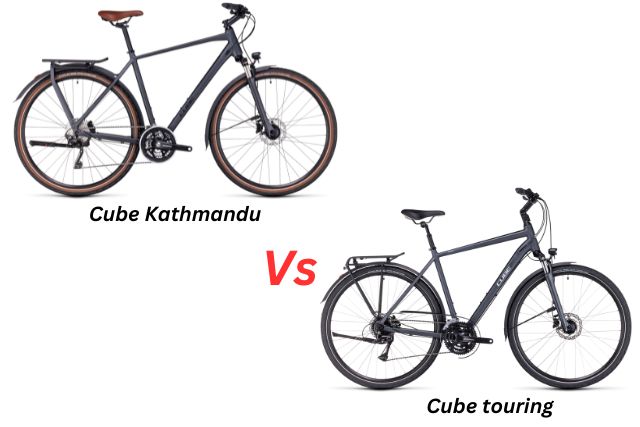
If you are looking for a versatile and comfortable bike for commuting, touring, or leisure riding, you might be interested in the Cube Kathmandu and the Cube Touring models.
These are two of the most popular urban bikes from the German brand, and they share some features and specifications. They have some differences that might affect your choice depending on your preferences and needs
We will compare the Cube Kathmandu Pro and the Cube Touring EXC, which are the top-of-the-line models in their respective series.
Frames
Both bikes have aluminum frames that are lightweight, durable, and easy to maintain. They have a similar geometry that is designed for comfort and stability, with a low standover height, a long wheelbase, and a relaxed head tube angle.
However, the Kathmandu Pro has a more advanced frame technology called IC 2.0 (Integrated Carrier), which means that the rear rack is integrated into the frame structure, making it more rigid and stable. The Touring EXC has a conventional rear rack that is attached to the frame with bolts.
The Kathmandu Pro also has internal cable routing, which gives it a cleaner look and protects the cables from dirt and damage. The Touring EXC has external cable routing, which is easier to access but less aesthetically pleasing.
Forks
The forks are one of the main differences between the two bikes.
Kathmandu Pro
The Kathmandu Pro has an air-sprung fork from SR Suntour, the NCX D LO Air, which has 63 mm of travel and a lockout feature. This fork is more adjustable, responsive, and lightweight than a coil-sprung fork, and it can absorb bumps and vibrations better on rough roads.
Touring EXC
The Touring EXC has a coil-sprung fork from SR Suntour, the NEX HLO, which also has 63 mm of travel and a lockout feature. It is cheaper, simpler, and more reliable than an air-sprung fork, but it is also heavier, less efficient, and less comfortable on uneven surfaces.
Read Also: which one is the fastest hybrid bike?
Wheels
Both bikes have 700c wheels, which are the standard size for road bikes and hybrids. They have aluminum rims that are durable and lightweight.
Kathmandu Pro
The Kathmandu Pro has tubeless-ready rims from Cube (EX23), which means that they can be converted to run without inner tubes, reducing the risk of punctures and improving the ride quality.
Touring EXC
The Touring EXC has regular rims from Cube (ZX20), which require inner tubes to hold air. Both bikes have Schwalbe Big Ben tires, which are wide (55 mm), puncture-resistant, and grippy on various terrains.
Brakes
They have hydraulic disc brakes from Shimano (BR-MT200), which are powerful, reliable, and easy to modulate in all weather conditions. They also have 180 mm rotors on both wheels, which provide ample stopping power and heat dissipation.
Related: Are Diamondback Hybrid Bikes Good?
Drivetrains
Both bikes have 3×10-speed drivetrains from Shimano, which offer a wide range of gears for different gradients and speeds.
Kathmandu Pro
The Kathmandu Pro has a higher-end drivetrain than the Touring EXC. It has an XT rear derailleur, a Deore front derailleur, a Deore shifter, a Deore cassette (11-46T), and an ACID E-Crank with a hollowtech II bottom bracket.
Touring EXC
The Touring EXC has a Deore rear derailleur, a Deore front derailleur, a Deore shifter, a Deore cassette (11-34T), and a T521 crank with an octalink bottom bracket. The XT rear derailleur is smoother, faster, and more precise than the Deore rear derailleur.
Gear Range and Crank
The Deore cassette on the Kathmandu Pro has a larger range than the Deore cassette on the Touring EXC (418% vs 309%), which means that it has lower gears for climbing and higher gears for descending or sprinting. The ACID E-Crank is lighter and stiffer than the T521 crank.
Other Components
They have similar components for the handlebar (Comfort Trail Bar), the stem (Performance Stem Pro), the seatpost (Performance Post), the saddle (Natural Fit Sequence Comfort), the pedals (ACID PP Trekking), and the grips (Natural Fit Comfort).
However, the stem on the Touring EXC is adjustable in angle, while the stem on the Kathmandu Pro is fixed. It means that you can fine-tune your riding position on the Touring EXC more easily than on the Kathmandu Pro.
Related: Specialized Chisel vs. Fuse: Compared
Conclusion
The Cube Kathmandu Pro and the Cube Touring EXC are both excellent urban bikes that can handle various riding scenarios.
They have similar frames, wheels, brakes, and other components, but they differ in their forks, drivetrains, and some details.
The Kathmandu Pro has a more advanced frame technology, an air-sprung fork, a tubeless-ready wheelset, and a higher-end drivetrain than the Touring EXC. These features make it more comfortable, efficient, and versatile than the Touring EXC.

